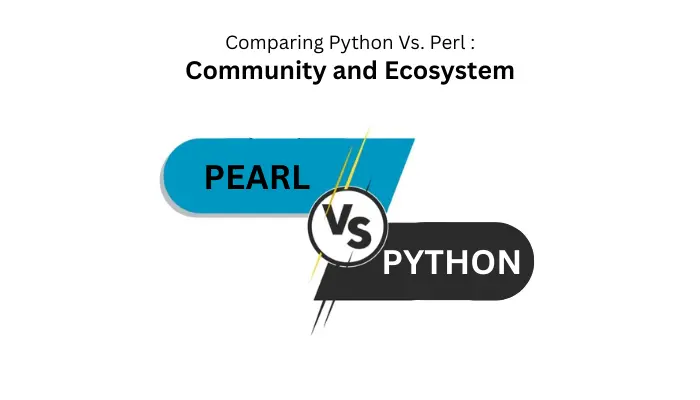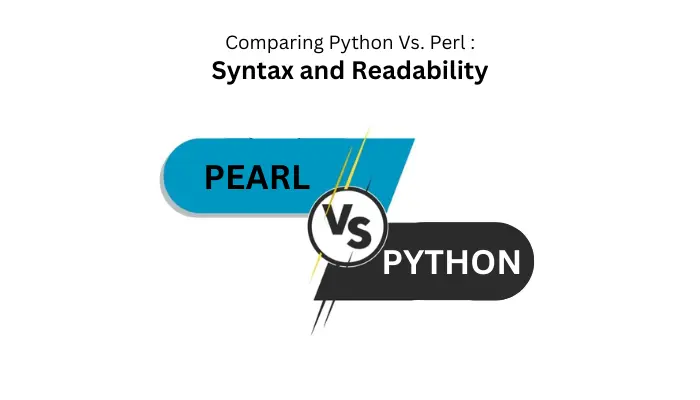When it comes to Perl vs Python Performance both are the most popular programming languages. But they have different features, use cases, and communities and perform different tasks.
In the evolving world of web development, the battle between Perl and Python has been a heated topic among developers. Both languages have their support and detractors’ expectations.
Both languages have been used for decades but Python has become popular and most developers prefer this as their first language.
Some big companies use Python like NASA, IBM, Google and have a community of programmers with 15.7 m developers.
The reason behind the popularity of Python is that it’s versatile, easy to use, and has a vast community of supporters. On the other hand, Perl is a high-level language that is used for CGI scripts.
But Perl is more than scripting; you might think it’s dead. It’s still relevant for the software engineers who work with LINUX/UNIX and others. If you are a seasoned developer who wants to know Perl Vs Python without further ado, dive into the blog.
Understanding Perl Vs Python
Before we dive into the performance, let’s talk about their history.
1. Perl: Text processing & Automation

Perl was created by Larry Wall in the late 1980s and has since gone through several versions where Perl 5 is the most widely used.
It is renowned for its powerful regular expression support, which allows complex text processing and manipulation. Perl excels in text processing, system administration tasks, and one-liners for quick scripting.
Moreover, it has a more compact and flexible syntax, often characterized by its ‘TIMTOWTDI’ –
There’s More Than One Way To Do It philosophy
This language has been historically favored by system administrators due to its ability to handle file processing, networking, and automation. It has a dedicated community, although it has somewhat declined in recent years in favor of newer languages.
2. Python: Coding For Novices & Experts

Python was created by Guido van Rossum in the late 1980s and has grown to become one of the most popular programming languages. It is known for its clear and readable syntax, emphasizing code readability and maintainability.
Moreover, Python has a large and active community, which can lead to more consistent and readable code. It is widely used for web app development, with frameworks like Django and Flask offering robust tools for building web applications.
Today, it has become a standard in scientific computing due to libraries like NumPay and SciPy, as well as Jupyter notebooks for interactive data analysis. However, its popularity in machine learning and data science has surged due to libraries. Python 2 and Python 3 are two major versions, with Python 2 no longer receiving official support as of January 1, 2020.
Perl Vs Python Features
Starting with features of Perl language, as it is a versatile language. But its complex syntax and multiple pathways can hinder beginners. It can be a maze full of maze and amazing things, this is what you can expect from Perl.
- With a lot of built-in functions used for operating system functions and support text processing.
- It has a very expensive nature due to this most code written in it, is short, and for large programs
- It gives you procedural programming with expressions, subroutines variables, and code blocks.
- Perl 5 with some added features helps in supporting object-oriented programming data structures.
- As of today, Pearl 5 is a CGI scripting language that is commonly used in network programming, finance, and system administration among others.
Perl advantages and disadvantages
| Advantages | Disadvantages |
| Excellent for text manipulation and processing tasks. | Perl’s syntax can be less intuitive and more challenging for beginners to grasp. |
| Powerful regex support for pattern matching and manipulation. | Perl code can become hard to maintain and scale as projects grow. |
| Can be used for various tasks beyond text processing, such as system administration and automation. | Perl’s web framework options are limited compared to other languages like Python or JavaScript. |
| An extensive library repository (CPAN) provides a wide range of modules for quick development. | Perl’s popularity has waned in recent years, affecting the availability of developers and resources. |
| Well-suited for quick script development and prototyping. | Perl’s unique syntax and features can present a steep learning curve for newcomers. |
| Often favored by system administrators for its built-in capabilities. | Some modules and resources might lack up-to-date documentation. |
| Many existing projects and systems are written in Perl, ensuring ongoing relevance. | Compared to newer languages, Perl lacks some modern language features and paradigms. |
| Support for concise, powerful one-liners for quick command-line scripting. | While Perl can be used for web applications, it’s less favored than languages like Python, Ruby, or PHP. |
| A dedicated community with a history of sharing and collaboration. | Perl’s execution speed may be slower compared to languages optimized for performance. |
| Existing Perl code can often be integrated and extended with minimal hassle. | IDE support for Perl might not be as advanced as for more popular languages. |
Python Features
Python language is an object-oriented language that helps programmers write clean code for small and large-scale projects. It is the first choice of developers for using it to develop web applications. With this let’s talk about the features of Python language.
- Python is easy to learn, and use.
- Plus, it has a prebuilt library that makes working easy.
- The best thing is Python code can run on different hardware and software.
- Debugging Python code is easy as it is simple to write.
- Integration of databases is possible while using Python, like MySQL, Oracle, and others.
- Easy to integrate with different programming languages like C++, C, Java, and others.
Python advantages and disadvantages
| Advantages | Disadvantages |
| Python’s clear and concise syntax enhances code readability, making development and maintenance easier. | The interpreted nature can lead to slower execution speeds compared to compiled languages. |
| It offers a rich selection of libraries, frameworks, and tools for app development, reducing development time. | GIL can hinder multi-core utilization and affect app performance in certain scenarios. |
| Python is a versatile language; it can be used for a wide range of app types, from web and desktop to mobile and data analysis. | While Python can be used for mobile apps it’s not the primary choice for native mobile app development. |
| It has amazing frameworks like Django and Flask that simplify web app development. | For real-time applications requiring instant response, Python might not be the optimal choice. |
| Strong and comprehensive community documentation provides solutions and support. | Extremely high-demand apps may require careful architecture and optimization to ensure scalability. |
| Its popularity in AI and machine learning allows easy integration of intelligent features into apps. | Managing dependencies and versions can sometimes lead to compatibility and deployment challenges. |
Perl vs. Python: Performance and Scalability
We have already discussed its pros and cons as both Perl and Python interpreted languages that may not match the performance of compiled languages for highly resource-intensive tasks.
Therefore, Python scalability is generally more favorable due to its versatility and extensive ecosystem, making it a more popular choice for a wide range of application sizes and complexities.
So let’s compare both based on their performances:
| Perl | Python |
| It is an interpreted language, which can lead to slower execution speeds compared to compiled languages. | Like Perl, Python is an interpreted language, which can result in slower execution speeds for certain applications. |
| It is known for complex regular expressions and text processing tasks, it might impact performance in resource-intensive scenarios. | The global interpreter lock (GIL) can limit the full utilization of multi-core processors, impacting multi-threaded performance. |
| While Perl’s performance has improved over the years, it might still lag behind languages optimized for high-performance applications. | Python can be slower for computationally intensive tasks. Slower than languages like C++ or Go. |
Comparing Python Vs. Perl: Community and Ecosystem

When it’s time to compare them based on community both have huge supporters. Let’s start with Python.
Python boasts a huge community that actively contributes to development and support. Numerous Python user groups and forums exist where developers can seek assistance and share knowledge.
Additionally, top Python app development companies contribute to the community and often offer resources for learners.
With this being said, let’s talk about the Python ecosystem.
Its ecosystem is extensive and diverse, with a plethora of Python frameworks available for various purposes.
Django and Flask are well-established Python frameworks that simplify web app development of libraries like NumPy, Pandas, and TensorFlow. This empowers developers in data science and AI domains.
Pearl Community
It has also a dedicated community, although it has declined in recent years. Developers can find help and resources on Perl-related forums & communities. But overall community size is smaller as compared to Python.
Plus, the involvement of Perl-oriented companies in the community might be less prominent.
When it comes to its ecosystem, it includes a wide array of modules available through the comprehensive Perl archive network (CPAN) makes it efficient for certain tasks.
However, for web application development, frameworks are less as compared to Python. This could impact the ease of development and access to cutting-edge tools.
Comparing Python Vs. Perl: Syntax and Readability

We have compared Python vs Perl based on community, performance, scalability, and so on. Now it’s time to look at the Syntax and readability.
Python’s syntax is notably readable and structured, which greatly contributes to the clarity of code especially in the context of Python app development.
The use of indentation as a structural element ensures a clean and coherent codebase. Moreover, Python’s emphasis on natural language-like constructs fosters code that is comprehensible even to newcomers.
And when it comes to its readability, Python prioritizes readability and self-documentation through meaningful variable names and consistent formatting.
This characteristic greatly assists in creating clear, easily understandable code a crucial aspect in Python app development.
Additionally, Python’s structured and orderly design enhances the logic flow within code, and the availability of well-documented libraries further aids in maintaining readability.
Perl syntax
Its syntax is celebrated for its versatile and concise nature, offering developers a multitude of approaches.
However, its flexibility might result in less uniform syntax, potentially impacting codebase maintainability. Complex regular expressions and special variables could lead to code that appears cryptic and intricate. It immediately affects readability in an application developed using Python.
When it comes to its readability it hinges on factors such as coding style consistency and the presence of extensive comments and documentation.
While Perl supports self-documenting code, as its multiple paths can lead to the same outcome.
Which is better Perl Vs Python?

Both Perl and Python were created to fulfill distinct programming needs, sharing similarities and differences. While Perl outpaces Python in terms of speed, several languages surpass Perl’s performance.
For beginners, Python shines as an easily, learnable language. In contrast, Perl proves intricate to grasp and master. Enterprises handling substantial projects may find Python a fitting choice while Perl suits smaller-scale undertakings.
However, Python’s ascent in the programming realm can be attributed to its extensive package support across diverse computing environments. As of late, Perl appears to wane due to the emergence of languages boasting superior features.
Conclusion
The choice between Perl and Python hinges on your project’s specific requirements, and your team’s familiarity and expertise. And the desired balance between performance and ease of development. In terms of hiring, businesses looking for expertise often prefer to hire Python developers, given Python’s popularity and ease of learning. Before hiring don’t forget to consult the cost to hire Python developers in 2023 might vary based on experience and location.
FAQs
In specific scenarios, Perl’s streamlined syntax may give it a speed advantage. However, other modern languages like C++, Rust, and Go now offer even higher performance benchmarks.
Yes, Perl can be used for web development, but Python’s extensive frameworks and libraries, such as Django and Flask, make it more favored for this purpose.
Yes, Python’s clear syntax and extensive learning resources make it a friendlier choice for newcomers compared to Perl’s potentially intricate syntax.
Python boasts a larger and more active community, supported by a rich ecosystem of libraries, frameworks, and tools, compared to Perl’s somewhat dwindling community.
Perl is renowned for text processing, regex, and system administration, making it ideal for those tasks. Python’s versatility makes it suitable for various applications, including text processing.
While Perl’s popularity has waned, it remains relevant for specific use cases. Newer languages offer modern features, potentially impacting Perl’s broader adoption.
Consider your project’s requirements and your team’s expertise. Perl offers niche strengths, while Python’s readability and versatility suit a wide range of applications.

Niketan Sharma is the CTO of Nimble AppGenie, a prominent website and mobile app development company in the USA that is delivering excellence with a commitment to boosting business growth & maximizing customer satisfaction. He is a highly motivated individual who helps SMEs and startups grow in this dynamic market with the latest technology and innovation.
Table of Contents












No Comments
Comments are closed.